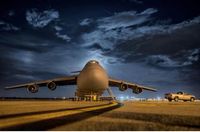In the ever-shifting landscape of global trade, the skies above are fast becoming the new battleground for economic supremacy. As of August 2025, the control of air freight networks—responsible for moving about 35 percent of the world’s traded goods by value, according to the International Air Transport Association (IATA)—is emerging as a key determinant of which nations and alliances will shape the world’s economic order for decades to come. Nowhere is this contest more evident than in the growing rivalry between the United States and the BRICS alliance, with South Africa standing out as a strategic hub in this unfolding drama.
South Africa, long known for its robust mining sector and as a regional economic powerhouse, is rapidly cementing its place as a gateway for international automakers, particularly from China and India. According to recent reporting, major brands such as Leapmotor, LDV, and Tata Motors are preparing to launch or expand operations in the country in the coming months. This surge of activity reflects a broader momentum in Africa’s automotive sector, as manufacturers look to capture new markets amid shifting global trade dynamics and strained relations between South Africa and the United States.
Leapmotor, a Chinese new-energy vehicle brand with a 20 percent stake held by Stellantis—Europe’s second-largest automaker—is set to enter the South African market in September 2025. The company plans to debut its C10 extended-range electric vehicle (EREV) at select Stellantis NV dealerships, with more models expected next year. This move follows Leapmotor’s successful launch in Mauritius and a record-breaking delivery of 48,006 vehicles in June, marking its second consecutive month of record sales. With its focus on electric vehicles, Leapmotor aims to tap into South Africa’s growing demand for sustainable mobility. As Mike Whitfield, managing director of Stellantis South Africa and Sub-Saharan Africa, put it, “South Africa offers the right combination of infrastructure, consumer demand, and regional connectivity to grow EV adoption.”
Not to be outdone, LDV—a sub-brand of China’s SAIC Motor Corporation—is preparing to launch its new Terron 9 bakkie at the Festival of Motoring at the Kyalami Grand Prix Circuit from August 28 to 31, 2025. The Terron 9, a large pickup designed to compete with premium models like the Ford Ranger Wildtrak and GWM P500, will be the brand’s flagship vehicle for the South African market. Since its debut last year, LDV has focused on the T60 midsize bakkie for private households. Bevan Nel, CEO of LDV South Africa, expressed enthusiasm about the upcoming launch, stating, “Exciting times are near as we prepare to launch the Terron 9 at the end of August, starting off with an exclusive sneak peek, we are excited to bring this powerhouse to the South African market.”
India’s Tata Motors is also making a strategic comeback to the South African passenger vehicle market, with a launch event slated for August 19, 2025. After halting exports to Africa in 2017-18, Tata Motors has partnered with Motus Holdings Ltd, South Africa’s leading passenger vehicle retailer, to distribute its SUVs, crossovers, and hatchbacks. The company’s plans include not just sales, but also local value creation, employment, and technician training. Yash Khandelwal, head of International Business at Tata Motors Passenger Vehicles, emphasized the company’s commitment, saying, “South Africa is an important market in our global expansion journey. With our class-leading products and a reputed partner in Motus, we are here to offer our South African customers a choice of vehicles that are safe, stylish, and innovation-driven.”
This convergence of launches by Leapmotor, LDV, and Tata Motors underscores South Africa’s rising status as Africa’s automotive and electric vehicle hub. The country’s established dealership networks, manufacturing capabilities, and consumer base make it an ideal launchpad for new-energy and mass-market vehicles. Analysts suggest that as more BRICS-based manufacturers view South Africa as a gateway to Sub-Saharan markets, the country’s influence in automotive trade will only increase. It’s no wonder some are calling South Africa the “Silicon Valley of African autos.”
But the story doesn’t end on the ground. In the skies above, the contest for dominance is playing out with equal intensity. The United States currently controls nearly 40 percent of global air cargo capacity through giants like FedEx, UPS, and Atlas Air. American hubs such as Memphis International Airport and Louisville Muhammad Ali International Airport are among the world’s largest, handling millions of tons annually. This control over air freight channels translates directly into influence over the speed and security of global supply chains.
However, the BRICS alliance is not standing still. The bloc is actively building alternative trade and transportation networks to reduce reliance on Western air cargo routes. The inclusion of Middle Eastern hubs—Dubai International Airport, King Abdulaziz International Airport in Jeddah, and Tehran’s Imam Khomeini International Airport—has expanded cargo capacity and created new corridors for high-value goods. Dubai alone has expanded its cargo capacity to over 2.5 million metric tonnes annually. Saudi Arabia, while officially denying BRICS membership, is investing over US$7 billion to expand its airport infrastructure, signaling deepening coordination with BRICS through economic cooperation and joint investments.
China, meanwhile, is leveraging its dominant cargo airline, China Southern Airlines Cargo, which operates over 300 freighters and handles more than 2.5 million tons annually. This supports Beijing’s Belt and Road Initiative, integrating land and air corridors across Asia, Africa, and Europe. New China-Europe air freight routes via Central Asia have increased volumes by 30 percent annually over the past five years, reducing reliance on Western hubs such as Frankfurt and Amsterdam.
The shifting landscape is further complicated by U.S. tariff policies. In August 2025, former President Trump extended the suspension of planned tariff increases on Chinese imports, maintaining a 30 percent rate. However, tariffs on goods from Brazil and India rose up to 50 percent, and those on EU and Japanese goods increased by 15 percent. These measures, while intended to protect domestic industries, have raised U.S. household expenses by an estimated US$2,400 annually and fueled frustration over rising prices for everything from clothing to automobiles. The tariff environment has burdened American companies with higher costs and uncertainty, prompting some to cut back on investment and slow down operations.
This has accelerated a realignment in global supply chains, favoring BRICS countries. Companies and nations are increasingly seeking to bypass American markets and logistics to escape punitive costs. Brazil and India, for example, have deepened intra-BRICS coordination, boosting trade agreements and infrastructure for cargo flows independent of Western hubs. China continues to expand its Belt and Road corridors, connecting Asia, Africa, and Europe while excluding U.S.-dominated routes.
Institutional shifts are also underway. The BRICS New Development Bank, with US$50 billion in capital, offers loans without IMF-style conditions, attracting countries under Western sanctions, including Russia and Iran. China’s Asian Infrastructure Investment Bank, financing projects exceeding US$200 billion, supports transport and logistics initiatives that compete directly with Western efforts. According to a McKinsey survey, 44 percent of global supply chain executives plan to reduce dependence on China within five years, reflecting the shifting trade flows and the search for more resilient supply networks.
Governments are hedging their bets. The UAE maintains close ties with both Washington and Beijing, investing in air cargo logistics and digital customs systems. Brazil balances its diplomacy, strengthening ties with China and the U.S. while leveraging its role as an agricultural export powerhouse dependent on air transport.
For the United States, the choice is stark: invest boldly in modernizing cargo airports and fleets, upgrade digital logistics and customs infrastructure, and reengage in multilateral trade agreements—or risk ceding strategic advantage in high-value air freight to BRICS and its partners. As control over the world’s air freight arteries becomes the decisive front in the battle for economic dominance, the future of global power may well be decided not in boardrooms or on the seas, but in the skies above.
With South Africa’s emergence as a continental gateway and the BRICS bloc’s relentless push to reshape trade and transportation networks, the global balance of power is shifting. The next chapter in economic leadership will be written in the clouds—where the stakes, quite literally, could not be higher.




